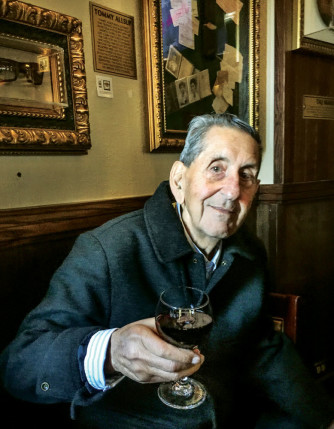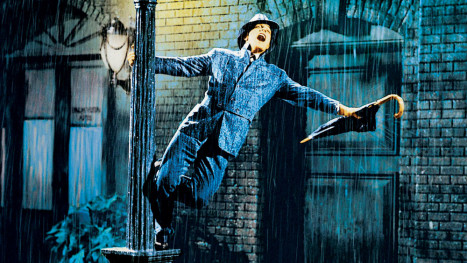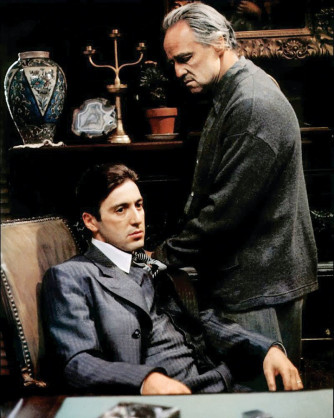
Each month the Indie Prof reviews a current film in the theater and a second film available at Redbox or VOD. However, this month he has two special reviews.
This column is dedicated to my father, Vincent Piturro Sr. (1925–2016).

Vincent Piturro Sr.
My father was my first film teacher: we watched movies incessantly when I was growing up. He was born at the end of the silent film era, in one of the greatest decades in the history of cinema—the 1920s. He grew up with the movies. I was born at the beginning of the other great decade in cinema history—the 1970s. We shared a love for the movies and spent countless hours watching the best movies of all time. Below are reviews of two of his favorite films, albeit for very different reasons. You may or may not have seen them, but you have heard of them. Perhaps this will inspire you to see them again, or for the first time (lucky you!).
Singin’ in the Rain (1955)
With the advent of sound film, many silent film stars were not able to make the transition. Whether they had foreign accents, regional accents, high-pitched voices, or they outlasted their fame, the movies changed literally overnight and most of the silent film stars found themselves out of work. Some of the performers who had previously worked in vaudeville were able to find work in musicals, but the new sound films demanded new stars.

Singin’ in the Rain
Singin’ in the Rain tells the story of this transition. Don Lockwood (Gene Kelly) and Lina Lamont (Jean Hagen) play a silent film couple who find difficulty in making the transition to sound because of Lina’s voice. Producer Arthur Freed, a former lyricist, combined an original story with many of his own songs from the previous 30 years to give the film a period feel in a contemporary setting. Kelly finished off the look and depth of the film with original dance numbers. The film has since become one of the most beloved and greatest films of all time.
It also marks the beginning of the end for movie musicals. The initial musicals of the 1930s were grand productions and highly stylized. Those gave way to more realistic musicals in the 1940s and early 1950s. Several factors contributed to the decline of the musical and eventually, all Hollywood production: changing public tastes; a foreign market no longer interested in musicals; the breakdown of the studio system; a changing demographic; and finally, TV. Anyone growing up in the 1930s and 1940s, however, loved the musical.
It is simple, fun, easy-to-watch, and it is an example of classic Hollywood cinema at its finest. The representations may be outdated, but the energy and star power allow the film to soar to heights rarely seen today. The technical aspects are stellar: the cinematography and Technicolor are brilliant, the sets are lush, and the dancing and singing numbers are flawless. Kelly was a notorious dictator on set, but you can’t argue with the results. I dare you to watch and not leave humming the famous tune that gives this wonderful film its name. If you love movies, as my father did, you will love this one.
The Godfather (1972)
The American film industry was going through an era of the new “auteur” in the 1970s with such directors as Francis Ford Coppola, George Lucas, Martin Scorsese, and Robert Altman gaining prominence and influence in Hollywood. That influence would not last long and the era of big Hollywood studios soon began at the end of the ’70s. But what a beautiful decade it was for the movies!

The Godfather
The Godfather takes place in the post-WWII era amid rapid economic growth, a mass exodus from the cities with the rise of the suburbs, and the rise of the American Mafia. There has always been a love/hate relationship between Italian-Americans and Mafia films, but there is more than a bit of truth in the representations that lend authenticity to the films. The Godfather is a prime example.
The film is a masterpiece, and it is continually voted as one of the 10 greatest films ever made. The storytelling is dense, the acting is superb, the cinematography is timeless, the editing is seamless and expressive, and the music perfectly complements while becoming a character of its own. It is a long film, but it is worth it. Pay attention to three scenes in particular that attribute to its greatness: the opening, which introduces us to the many characters; the ending, one of the most famous cross-cutting scenes in the history of cinema; and the scene at the hospital where Michael (Al Pacino) finds his father Vito (Marlon Brando) alone.
When Michael takes Enzo’s lighter on the steps of the hospital and then looks down at his hands (which are not shaking), I was hooked. It is pure visual storytelling at its finest. My father and I discussed that scene when I was just a little boy, and I knew then that my love for the movies and our shared love would never die. And that still holds true.
Both of these films are genuine masterpieces, films that leave you saying “they just don’t make them like that anymore.”
Just like my dad.
Vincent Piturro, Ph.D., is an associate professor of Cinema Studies at MSU Denver.



A couple of questions.
Was there an emblem on the lighter that Michael was looking at? Just at his hands? Listening to the sirens?
Do you know where the train station is, at which Vito arrives, and from which he later leaves, on his visit to Sicily for revenge?
Sorry for such a delayed response!
To answer your questions:
1. Michael was just looking at his hands. The important point is that Michael realizes that his hands are not shaking and he is not overwhelmed by the tension (as is Enzo in that scene). Michael realizes, in that moment, that he was made for this life.
2. Not positive, but most research points to a station in Palermo. They shot it in Sicily.
Thanks!
Thanks. No, the train station is closer to Catania and Taormina (I think I found it), as is the house of Don Ciccio, and the locations of the other scenes in GFII. In GFIII, they used some locations in Palarmo, as well as at the East end of the island. Like the train station where Kate arrives, and some old locations from GF and GFII.
Don Ciccio’s villa is pretty cool too.